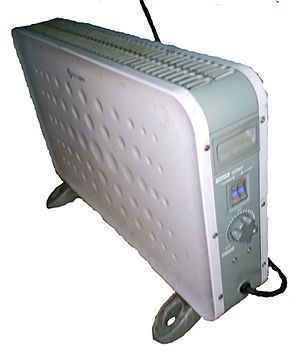Convection heater facts for kids
A convection heater (otherwise known as a convector heater) is a type of heater that uses convection currents to heat and circulate air. These currents circulate throughout the body of the appliance and across its heating element. This process, following the principle of thermal conduction, heats up the air, reducing its density relative to colder air and causing it to rise.
As heated air molecules rise, they displace cooler air molecules down towards the heating appliance. The displaced cool air is heated as a result, decreases in density, rises, and repeats the cycle.
Contents
History
Ancient heating systems, including hearths, furnaces, and stoves, operated primarily through convection. Fixed central hearths, which were first excavated and retrieved in Greece, date back to 2500 BC, while crude fireplaces were used as early as the 800s AD and in the 13th century, when castles in Europe were built with fireplaces with a crude form of chimney.
Developments in convection heating technology included the publication of the very first manual on fireplace design called Mechanique du Feu in 1713, the creation of stoves with thermostatic control in 1849, and the rise of numerous cast iron stove manufacturers during the American Civil War.
The Model "S", illustrated by the Sala Heater & Mantel Co. in Dallas, Texas in 1924, is an example of an early model of a convection space heater. This model consisted of three stoves and was considered to be a highly efficient radiant type of gas heater at the time. It utilized radiant heat, and supplemented its power by drawing cold air through the facing, heating it, and forcing it out through the register. This allowed air circulation while maintaining a cool exterior on the appliance.
These early developments, along with the technological advancements made possible by electricity and inventions of tools like thermostats, gave way for the design of modern convection heaters.
Types
Convection heaters are commonly classified according to their power source. Electric convection heaters use electricity, while combustion or gas-fired heaters use gas, propane, or any other type of fuel. For the heating element, convection heaters usually use metal coils, nickel-chromium, resistance wire, thermal liquid, or ceramic.
Panel heater
A panel heater is a type of electric convection heater commonly used for whole-room heating in residential and small commercial settings. They are often mistaken for electric radiators, which are devices that use radiant heating and transfer heat directly to objects rather than using the air as medium. Panel heaters are typically used in complement to some other primary or central heating system. They are usually fitted with time and temperature controls.
Fan heater
Fan heaters combine the warming capability of a heater and air distribution capacity of a fan. The earliest fan heaters became available in the 1950s, right after the invention of tangential fans. Modern fan heaters have variable-speed fans that can work independently from the heating element.
Institutional convector heater
Institutional convector heaters are heavy-duty heaters designed strictly for commercial and industrial use. Their construction is designed to reach a broad surface area.
Oil heater
An oil heater, also called a column heater, is electrically heated and uses oil as a heat reservoir. Because oil has a high heat capacity and a high boiling point, it is a suitable heat pathway between the heating element and the cavities of the heater unit.
Gas-fired convection heater
Gas-fired convection heaters use a gas supply instead of electricity. These heaters consist of a gas burner, an air filter, gas valves, a blower, and a thermostat.



